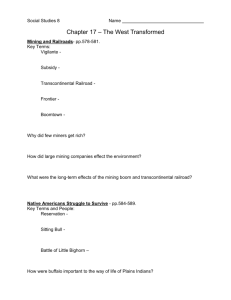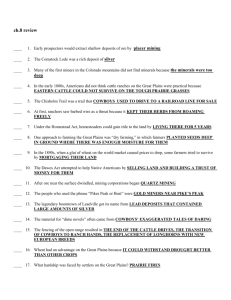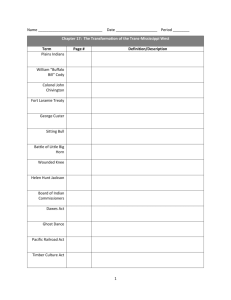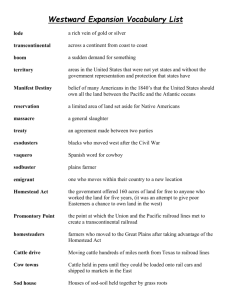Westward Expnasion Notes
advertisement
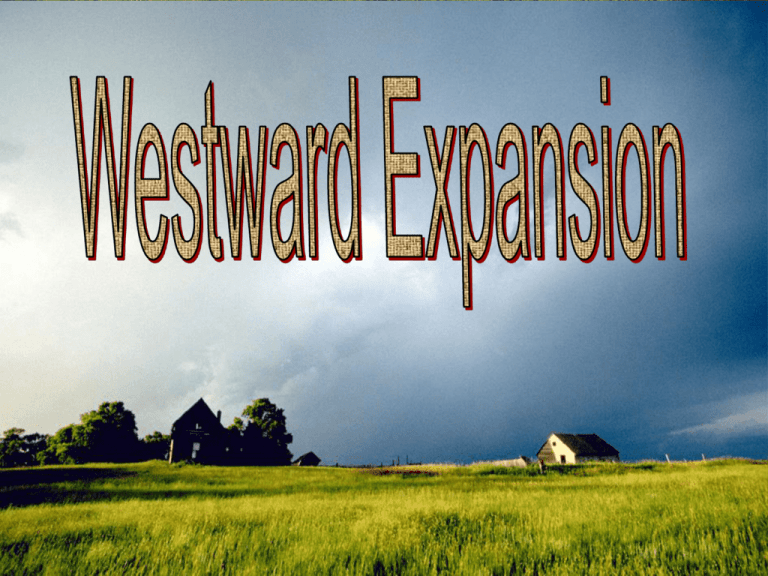
What do you know about Westward Expansion? Write down your responses. Analyze this painting. What do you think it means? Write down your response Topics of discussion Native American Culture • Tribes relied on the buffalo to survive – Native Americans on the Great Plains would follow the herds across the land (nomadic). – They used these animals for food, shelter, and clothing. – White settlers were hunting these animals for sport. U.S. Government’s Response to N.A. • In the beginning, the U.S. government offered peace – In 1851, the Treaty of Fort Laramie guaranteed Native Americans land rights on the Great Plains. U.S. Government’s Response to N.A. • The belief of manifest destiny encouraged countless Americans to pick up their belongings and head out west in search of a better life – This caused the U.S. government to rethink its policy of dealing with Native Americans. U.S. Government’s response to N.A. • The government set up the Bureau of Indian Affairs (BIA) to manage Native American issues. – The chief of the agency, Luke Lea, supported the system of reservations. – Reservations: land set aside for Native Americans to live on and farm. Intro Questions: • Was it a necessity for the United States due to the concept of “manifest destiny” or not? • What else could the United States have done other than the reservation system? • Do you think the idea of placing Native Americans on reservations is an idea that many Americans do not care about today? If so, do you think that is wrong? Voices of Protest • Horrific treatment of Native Americans led to the formation of organizations to protest such treatment. • In addition, Helen Hunt Jackson wrote the book, A Century of Dishonor, which criticized the government for its years of broken promises and mistreatment of Native Americans Multiculturalism Assimilation Discrimination Segregation Genocide Native American Assimilation • In the late 1800’s, the U.S. government felt the long-term solution to a peaceful existence with Native Americans was assimilation. • The government: – Set up “Indian schools” – Passed the Dawes General Allotment Act Do you think people are assimilated into American society and they don’t even realize it? Explain your answer. Government lures people out West • Homestead Act: permitted “any citizen or intended citizen to select any surveyed land up to 160 acres and to gain title to it for five years’ residence” if the person cultivated (farmed) the land. • Morrill Act: granted more than 17 million acres of federal land to the states and ordered the sale of this land to finance the construction of agricultural and engineering colleges. Other ways to gain land • Citizens could also gain land from events called “land rushes.” – One of the most famous was the Oklahoma land rush Water • Water was always in short supply in a large portion of the West. • Some solutions were irrigation systems and windmills Trees • Trees were also in short supply on the Great Plains • Farmers needed the wood from trees as a fuel source or for building materials. Solutions to the lack of trees • As a substitute for wood, they used dried buffalo manure for a fuel source. • They used heavy layers of soil to build homes, which were called sod houses Climate • Blizzards and brutal cold gripped the Great Plains during the winter while summer brought soaring temperatures and drought. • Insects ran rampant on the Great Plains and devoured almost everything in their paths, ruining a harvest. The Government steps in to help farmers • U.S. Department of Agriculture was created in 1862 to help farmers adjust to their new environments. Farmers, have no fear, the government is here!!! New Farming Methods of the West • New plows with durable blades helped to easily cut through tough soil. • Many of the new devices utilized the steam engine. – Many of these new devices were extremely expensive and plunged farmers into massive debt. • Large companies practiced large scale farming called bonanza farming. People flood the west looking to get rich • Gold was discovered in Pikes Peak, Colorado in 1858 and was invaded by western settlers. • The Carson River valley (in present day Nevada) offered miners a new place to get rich when it yielded gold as well as the Comstock Lode, one of the world’s richest silver veins. • U.S. miners pushed all the way into western Canada in search of riches. – One of the results of this was the purchase of Alaska from Russia in 1867. Mining Life • Mining communities were almost entirely male. – Families did not accompany the miner. • The atmosphere in mining camps was one of extreme competition as everyone was looking out for themselves. Mining Violence • Deadwood, South Dakota was legendary for its violence. Prospecting Mining Centers: 1900 Mining (“Boom”) Towns-Now Ghost Towns Calico, CA Big Business Mining • In the early years of mining, the individual miners had exhausted much of the easily accessible minerals from the mines. • Getting to minerals deep beneath the surface would require new technology that could only be supplied by large corporations. Ok little miner, we’ll take it from here Corporate Mining Techniques Hydraulic mining: water shot at high pressure ripped away gravel and dirt to expose the minerals beneath. Hard-rock mining: involved sinking deep shafts to obtain ore locked in veins of rock. Dangerous Working Conditions • There was also a risk of injury or even death due to cave-ins, rockfalls, and the use of dynamite. • Poor ventilation caused the air to be dangerous to breath. History of Ranching in the West • The Spanish were the first to introduce cattle to the American West. Yeah we brought cattle to America!!!!!!!!! History of Ranching in the West • Eastern cities of the United States grew in population and ensured a strong demand for beef. MMMM….. Beef History of Ranching in the West • The demand and price of cattle increased as the buffalo began to die out. Hey, where are all my friends???? The Economy of Cattle • The workers who took care of a rancher’s cattle were known as cowboys. NOT Cowboys • Cowboys were also in charge of herding as many as 3,000 cattle to the railroad stations sometimes hundreds of miles away. • These trips were called long drives. The Cattle Trails Problems for Cowboys • A sudden sound could spook the cattle into a stampede, which would endanger not only the cowboys but also the herd. • Cowboys worked for little pay in all types of weather conditions. Cattle (Cow) Towns • Long drives ended at places called cowtowns, towns located along railroads where cattle would be shipped to the east. • Famous cowtowns were Dodge City, Abilene, and Wichita. Cattle (Cow) Towns • These towns became synonymous with drinking, gambling, and lawlessness. • It was in these towns that famous law enforcers like Wyatt Earp became American legends. The Open Range • As the U.S. government acquired more Native American land, they allowed cattle ranchers to use public land as open range, or free grazing land for their cattle. • Huge corporations took advantage of this offer and utilized millions of acres for ranching. The Roundup • During the spring and fall months, hired cowboys would “roundup” the rancher’s cattle from the open range. • They would distinguish between different ranchers’ cattle by the various branding marks left on the skin. Land Use: 1880s The Range Wars Sheep Herders Cattle Ranchers Reasons the Cattle Boom Ended • Greedy ranchers overcrowded the open range with too many cattle, i.e. there was too high of a supply thus the price dropped. • The invention of barbed wire by Joseph Glidden limited cattle access to land and water. • Drought and a horrific blizzard decreased the number of many herds.
